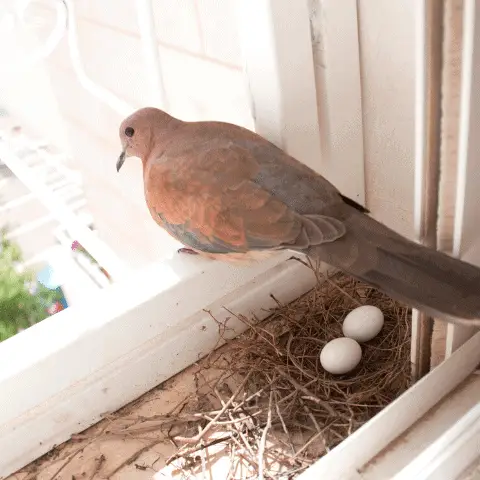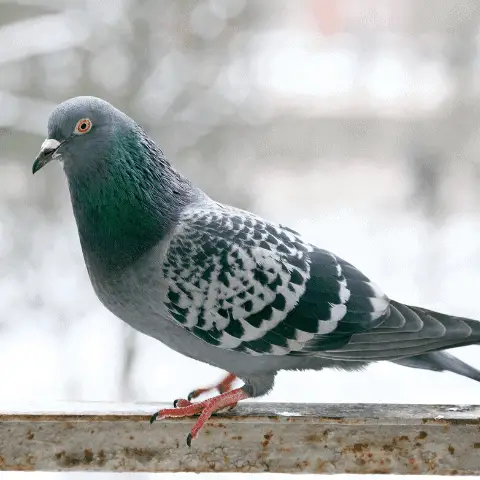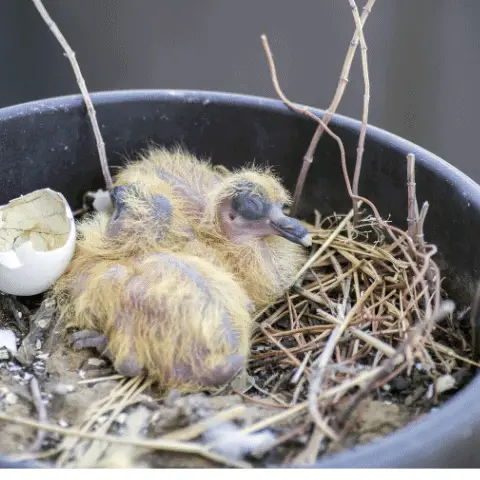Did you find a pigeon nest with eggs in the geranium pot on the balcony? I bet that’s why you’re reading this article. Maybe you’re wondering what to do with it.
Do you keep it? Can you touch the pigeon eggs? Should you feed the mother bird?… Well, think again.

What should be done if you find a pigeon’s nest on your balcony?
If you find a pigeon’s nest on your balcony, the best thing to do is to get rid of it. Pigeons represent a severe health hazard for you and your loved ones. Do not touch it with your bare hands. Wear a pair of gloves, and remove it from your balcony.
Get rid of the nest together with its eggs. In order to discourage the mother to return to the nest, try placing a toy snake where you found the nest. Hopefully, this will scare the bird for a while.
Am I too cruel? Probably. However, as much as I love animals, in this specific case, I have no doubts: get rid of the nest and the eggs as fast as you can! Let me explain why.

Comics by AnatPlantz
Are pigeons dangerous?
Pigeons, especially those who live in the city, are carriers of diseases that sometimes can be very serious. They are not the kind of animal you want to keep as a pet on your balcony.
Not to mention how messy they are! Yes, you guessed it right. I am talking about their infamous droppings. Worthwhile mentioning it, three primary diseases are associated with pigeons that are dangerous for humans: Histoplasmosis, Cryptococcosis, and Psittacosis. Let’s explore this topic a little bit more.
HISTOPLASMOSIS:
Histoplasmosis is an infection caused by breathing in the spores of a fungus found in bird droppings. This disease affects the lungs. You can catch this disease by inhaling the spores in the air while performing cleaning jobs or any other type of project (such as renovations or demolitions) that can raise high levels of spores in the air, . The majority of people are asymptomatic; however, Histoplasmosis can be dangerous for those with a compromised immune system, such as infants and the elderly. As I said before, the majority of people won’t develop any symptoms, however, when the infection is severe, it can lead to a high fever, chest pains, and fatigue.
Some people can develop a chronic form of Histoplasmosis, which includes a bloody cough, mimicking symptoms of tuberculosis. If untreated, this disease could be fatal.
CRYPTOCOCCOSIS:
Cryptococcosis is caused by a fungus known as Cryptococcosis neoformans. It is a disease that affects the lungs and is associated with pigeon droppings, soil, and unwashed fruit. This disease is contagious and can spread from person to person. Generally, healthy people won’t develop any symptoms, but people with a compromised immune system such as elderly or infants are at a higher risk for contracting the disease. This infection attacks mostly the lungs, with minimal symptoms. In some rare cases, however, it can spread to the brain, the urinary tract, and the bones. When the infection reaches the brain, it can lead to meningitis and other serious complications.
PSITTACOSIS:
Psittacosis is also known as Ornithosis or Parrot Fever. It is an infection caused by a Chlamydia Psittaci, a fungus present in bird droppings. People can catch the disease by inhaling the fungus spores that are in the air. Symptoms can vary from headache, fever, dry cough, and pneumonia. People who are most affected by this disease are pet shop owners, workers in aviaries, and veterinary facilities. Psittacosis cannot be transmitted from person to person.
If the above still hasn’t convinced you, here is a list that will change your mind. You really don’t want to keep these pesty birds anywhere near you. Besides being disgusting, pigeon droppings are corrosive and can cause significant damage to roofs and balconies. It is also really difficult to scrap it from floors, and most probably will leave a stain if not cleaned in time. Also, the droppings are really hard to remove from smooth surfaces such as your car, the patio floor, but also from your clothes and your shoes.
The droppings can attract other unwelcome guests to your premises, such as flies and rats. Pigeons might cause damage to your vegetable garden. These birds are territorial and will scare smaller beneficial birds such as hummingbirds. They tend to return from season to season, which makes it very challenging to chase them away.
Well, now that I have convinced you to dispose of the pigeon’s nest with its eggs, comes the messy part: how to clean the balcony from pigeon droppings.
How to clean pigeon droppings
Generally speaking, cleaning windows and windowsills does not pose a health risk to you or to your family. However, you will need to take some precautions such as:
- Wearing disposable gloves and a mask
- Wearing closed-toe shoes
- Washing your clothes immediately after dealing with the droppings
- If you are thinking of scraping the dropping, wet them beforehand, to prevent inhaling the fungus spores that float in the air.
- Brush with warm soapy water. Where needed, you can add some baking soda to the soapy water solution. Throw away the brush or the sponge-cloth that you used for cleaning.
- Rinse thoroughly with a hose.
As I said before, pigeons will return, and once they spot your balcony as their favorite nesting place, you are doomed. They will return every season and nest there.

How do you tell if a pigeon is going to lay eggs in your balcony?
As soon as spring comes, around March/April, pigeons begin to look for air vents, vases, hidden corners on the terraces to establish their nest and create a family. You will surely notice a continuous flutter forward and backward. It’s the parents which take turns as soon as they establish their nest.
It will be challenging to move them. These birds will remember your house and will want to go back for generations.
How to get rid of pigeons & How to prevent them from returning to your home
The secret to prevent pigeons from returning to your house is to make their landing place as inconvenient as possible. This is what you can do to scare pigeons off your property and to prevent from nesting in the future:
- Install some anti-roosting spikes. They are by far the most effective pigeon deterrents. I found them on Amazon and are pretty easy to install.
- Install a bird deterrent gel that is commercially available and that works on a multi-sensory level using sight, smell, and touch. This gel makes the surface where the pigeon lands very sticky.
- Install a wind chime on your balcony or your patio.
- Fasten some aluminum foil strings on your balcony railings.
- Put a decoy crow on your roof. Move the crow from time to time as pigeons are very clever and they will get use to it.
- Put a screen over attic vents, chimneys, and anywhere they can create a nest.
- Put a toy snake on your balcony or the place where they might build their nest. Once I made my own decoy DIY snake from a souvenir alligator head from Florida. I filled a black sock with some clothes and slipped it on the alligator’s head. (A word of advice: as time passes, just remember where you placed the snake… it might suddenly scare you to death when you least expect it! I am speaking from experience!)
I hope I have convinced you that pigeons are messy and also carry parasites. You won’t regret getting rid of their nest. Besides, have you ever seen what pigeon chicks look like? They are the scariest chicks ever!!

Some of the links above are affiliate links, meaning at no additional cost to you, I will earn a commission if you click through and make a purchase.
